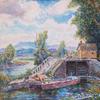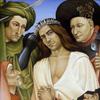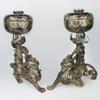Traveling Exhibition Features the Transcontinental Railroad and the American West
- OMAHA, Nebraska
- /
- July 19, 2018
Union Pacific, in partnership with Joslyn Art Museum and the Union Pacific Museum in Council Bluffs, Iowa, announced a new traveling exhibition in recognition of the 150th anniversary of the completion of the transcontinental railroad. The Race to Promontory: The Transcontinental Railroad and the American West celebrates the “Meeting of the Rails” at Promontory Summit, Utah, on May 10, 1869, through the photographs and stereographs of Andrew Joseph Russell (1830–1902) and Alfred A. Hart (1816–1908). Drawn exclusively from the Union Pacific Historic Collection, located at the Union Pacific Railroad Museum, these images represent the largest collection in the world of original photographs documenting the construction of the transcontinental railroad between 1866 and 1869.
Appropriately, this transformative endeavor was captured by the equally groundbreaking medium
of photography, which was used to document the railroad’s arduous construction and then capture the
moment of its completion and distribute it around the world. From east to west, the Union Pacific
line was photographed by Russell, and west to east by Hart, for the Central Pacific. The Race to
Promontory features 50 framed Imperial plate albumen prints by Russell, including images from his
album, The Great West Illustrated, as well as rare, unpublished prints from the Union Pacific Collection, including Russell’s famous image from Promontory Summit, East and West Shaking Hands.
One hundred eight stereograph cards by Hart will also be displayed, and two stereograph viewers will allow museum visitors to view Hart and Russell images in three dimensions.
In the decade following the Civil War, Russell and Hart benefited from an unprecedented wave of
government and corporate patronage that supported a legion of photographers working in the
American West. And while no endeavor caught the nation’s interest more readily than the construction
of the transcontinental railroad, their images also helped to define the unfamiliar landscapes beyond
the Missouri River, capturing not only the engineering triumphs of the railroad, but the vast resources
available for an expanding nation, as well as its pictorial beauty. Russell and Hart’s photographs offer
an extraordinary account of the United States at the moment of its transformation by the greatest
industrial accomplishment of the nineteenth century, images that still resonate powerfully a century
and a half after their making.
Highlighting the Joslyn installation will be the three original ceremonial railroad spikes that were
presented during the festivities at Promontory Summit on May 10, 1869. Reunited for the first time in
150 years, the Gold Spike, the Silver Spike, and the Arizona Spike were given to railroad officials to
celebrate the laying of the last rail and have not been displayed together since that day. Two of the
spikes, the Gold Spike and the Silver Spike, are in the collection of the Cantor Museum at Stanford
University, and the Arizona Spike is part of the collections of the Museum of the City of New York. This
spike has been on display since 2003, at the Union Pacific Railroad Museum in Council Bluffs, Iowa.
The exhibition will also include archival material from the Union Pacific Collection including
commemorative objects relating to the events at Promontory Summit, as well as artifacts and records
from the construction of the railroad.
The completion of the transcontinental railroad was as celebrated a national – and international –
event as the first moon landing, exactly a century later in 1969. Forty‐six months after they began
construction, the two railroads came together and officially "united" the United States. Western Union
offered coverage direct from the scene—the first major news event carried "live" from coast‐to‐coast.
Telegraph wires were attached to one of the ceremonial spikes and as it was gently tapped with a silver maul, the “strokes” were heard across the Country. Whistles were blown in San Francisco, the Liberty Bell was rung in Philadelphia, and a ball was held in Washington, D.C.
The transcontinental had opened the heart of the continent, and, within days of its completion, the
country was transformed. Travel from New York to San Francisco was reduced from six months to 10
days, and at ten percent of the cost. This new era witnessed the development of settlements for
millions of Americans and an incredible surge in industrial growth. Agricultural products were
transported east from California, changing how Americans filled their dinner tables. The railroad led to
the creation of Standard Time, to allow trains to move safely along a single track. Communication
flowed quickly and reliably across the country on mail cars and by telegraph lines along the track. The
railroad also connected the United States to the world, carrying products from Asia and Europe—the
first freight shipment across the new railroad included casks of tea from Japan—and building new
markets for both imported and exported goods.
On a larger scale, the railroad also obliterated the idea of the “frontier,” and forever changed the
lives of indigenous Plains tribes, as new migration spurred by the railroad hastened the end of the
Indian Wars and the beginning of the reservation era. The Pacific Railway and Homestead Act insured
the resettlement of new territories under the control of the federal government, reinforcing the 19th
century ideal of Manifest Destiny as the United States expanded from sea to sea.
Joslyn Art Museum, Omaha, NE: October 6, 2018 – January 6, 2019
Utah Museum of Fine Arts, Salt Lake City, UT: February 1 – May 26, 2019
Crocker Art Museum, Sacramento, CA: June 23 – September 29, 2019















